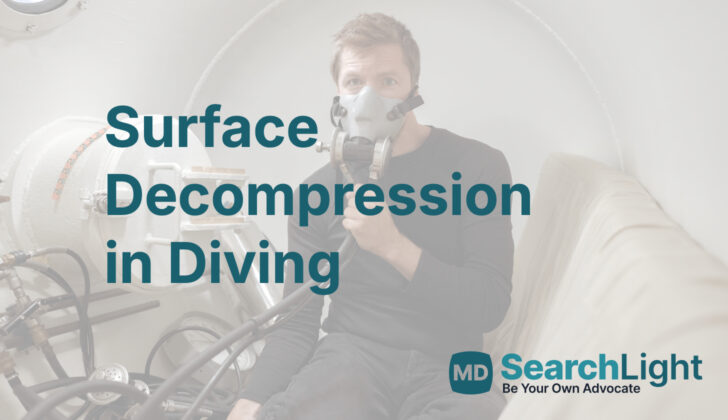Overview of Surface Decompression in Diving
Surface decompression, or Sur-D, is a method mainly used in military and commercial diving where the diver gradually reduces the pressure they are under. In this technique, the diver starts decompressing, or getting used to normal pressure levels, while they are still underwater. Once they reach the surface, they continue the decompression process in a special chamber on the deck, known as a deck decompression chamber (DDC).
Why do People Need Surface Decompression in Diving
The process of surface decompression is a specialized technique used in scuba diving. This requires a decompression chamber, a type of sealed device where pressure can be controlled, and is often not accessible to regular or hobby divers. This method is primarily used during diving operations where there’s a need to quickly get divers in and out of the water.
Surface decompression can also be useful when the ocean or sea conditions make it tricky to stay in water for the usually necessary decompression periods. In these cases, it’s safer and easier to decompress on the surface, rather than in the water.
This technique can be applied whether the divers are using regular air tanks or mixed gas tanks with helium and oxygen (HeO2). So, even in potentially tricky or risky circumstances, this technique provides a safer alternative for divers to decompress and avoid possible health risks of staying in water too long.
Equipment used for Surface Decompression in Diving
Surface decompression is typically linked with a type of diving called surface-supplied diving. In this diving technique, the divers get their supply of compressed gas from the surface, which is sent to the dive equipment they are wearing through a flexible tube. Surface decompression necessitates the use of a special container known as a deck decompression chamber (DDC), an image of which can be seen below.
How is Surface Decompression in Diving performed
Understanding the process of decompression is important in diving activities. Let’s break it down into simpler terms. First off, seawater is heavy – it weighs around 64 pounds for each cubic foot or 1024 kilograms per cubic meter. For diving purposes, we consider this weight to be the same as freshwater even though freshwater is slightly less heavy.
As a diver goes deeper into the water, they feel more pressure due to the weight of the water above them. To give you an idea, if at the surface the pressure is say X, then:
- At 33 feet below the surface, the pressure is twice as much – 2X
- At 66 feet down, it becomes three times – 3X
- At 99 feet, it’s four times – 4X
For the diver to breathe underwater, the diving equipment supplies breathing gas that is the same pressure as the water around them.
Both military and commercial divers use compressed air, which is mostly nitrogen, for dives less than 200 feet (or 60 meters) deep. Beyond this depth, the nitrogen can cause cognitive impairment, also known as nitrogen narcosis, so a mixture of helium and oxygen is used instead. Recreational divers also often use a mixture of helium, nitrogen, and oxygen to reduce the risk of nitrogen narcosis.
When a diver is on the surface, the dissolved gases in the body are at the same pressure as the atmosphere. But as they go deeper, the pressure of the breathing gas increases. This means more gas gets dissolved in the blood and body tissues. The deeper a diver goes and the longer they stay underwater, the more gas dissolves.
As the diver ascends or comes back up towards the surface, the pressure in the lungs decreases, and the pressure of the dissolved gases in the body becomes higher than the pressure in the lungs. The excess gases in the body are then exhaled through the lungs. This is a simple explanation of decompression.
Mind you, some amount of supersaturation (the condition where there’s more dissolved gas in the blood and body tissues) is normal and can be handled by the body. But too much of it can cause bubbles to form in the body, leading to a condition called decompression sickness, with symptoms like joint pain, dizziness, and shortness of breath.
Surface decompression is a technique used to control this process of gas release and to safely ascend from a dive. In this procedure, the diver ascends to the surface with pauses at specific depths. The aim is to prevent the development of decompression sickness symptoms during the time spent on the surface before the diver is recompressed in a decompression chamber.
Commercial diving operations sometimes already pressurize the decompression chamber to a certain depth even before the diver reaches the surface. After reaching the surface and removing the diving gear, the diver enters the chamber to finish the decompression process. The diver continues to breathe oxygen in the chamber to facilitate the release of the excess inert gases from their body.
Possible Complications of Surface Decompression in Diving
What Else Should I Know About Surface Decompression in Diving?
If you’re a healthcare worker who works with professional or military divers, it’s really important that you understand how decompression procedures work. Decompression refers to the process divers undergo after deep dives to slowly adjust to normal pressure levels. Surface decompression, a type of decompression, can be pretty complicated and needs a proper team of diving experts.
Also, as a healthcare professional in such a setting, you should be aware of possible problems that can pop up during this procedure. That way, you can be ready to help the dive team and give appropriate care to injured divers. This might involve discussions with the diving professionals or treating any injuries that occur due to complications during the procedure.











